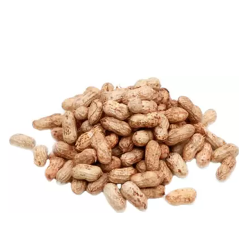



A legume crop farmed primarily for its edible seeds is the peanut (Arachis hypogaea), also known as the groundnut, goober (US), pindar (US), or monkey nut (UK). It is widely cultivated throughout the tropics and subtropics, and both small and significant commercial producers depend on it. It is categorised as a grain legumeand an oil crop because of the amount of oil it contains. China accounted for 38% of the global total of 44 million tonnes of shelled peanut production in 2016. Peanut plants grow their pods underground (geocarpy), which is unusual for legume crop plants. Carl Linnaeus, a botanist, gave peanuts the species name hypogaea, which translates to "beneath the soil," in recognition of this feature.
The plant family Fabaceae (or Leguminosae), also referred to as the legume, bean, or pea family, includes the peanut. Peanuts, like the majority of other legumes, have symbiotic nitrogen-fixing bacteria in their root nodules. Since of their ability to fix nitrogen, peanuts are useful in crop rotations because they reduce the need for fertiliser that contains nitrogen and increase soil fertility.
As a culinary nut, peanuts are frequently prepared similarly in Western cuisines to tree nuts like walnuts and almonds because they have a comparable flavour and nutritional profile. According to botany, a nut is "a fruit whose ovary wall hardens at maturity." The peanut is not considered a nut under this standard. However, for culinary purposes and in ordinary English, peanuts are typically referred to as nuts.
Ayurveda's use of groundnuts dates back to the 14th century. Peanuts, known in ancient Ayurveda as Kalaya, are mentioned for their capacity to balance, alleviate, and treat illnesses brought on by the kapha and pitta doshas. Practitioners of traditional medicine suggest peanuts for treating a variety of ailments, including memory loss, diabetes, weight reduction, and problems with the skin and hair.
Controls Diabetes: Because they help lower blood sugar levels, groundnuts are a perfect snack for diabetics. Grab a handful of roasted peanuts to quell your hunger and avoid a sharp rise in your blood sugar levels. According to studies, peanuts contain 21% of the mineral manganese for every 100 grammes, which is important for calcium absorption and blood sugar control.
Cancer prevention: A rich source of beta-sitosterol, which helps to prevent malignancies in the body, may be found in peanuts. It prevents tumour growth, particularly in cases of cervical and breast cancer.
Protein, good fats, and dietary fibre are all in great supply in groundnuts. Due to their high potassium, calcium, phosphorus, and B vitamin content, groundnuts can provide you with a number of health benefits. A fantastic source of fibre, protein, and heart-healthy fats, groundnuts also help control blood sugar levels and reduce the risk of heart disease.
There are four primary varieties of peanuts, according to the National Peanuts Board: runner peanuts, Virginia peanuts, Spanish peanuts, and Valencia peanuts. These can be found in a variety of forms, including raw, in-shell, shelled, dry-roasted, and oil-roasted. The most nutrient-dense food is raw peanuts, which has invaluable health advantages.
16 g of total carbohydrates
9 g of dietary fibre
4 g of sugar
26 g of protein
49 g total fat
7 g of saturated fat
16 g of polyunsaturated fat
24 g of monounsaturated fat
0 mg of cholesterol
18 mg of sodium
705 milligrammes of potassium
B1 vitamin, 0.9 mg
B2 vitamin, 0.2 mg
17.6 milligrammes of niacin
B6 vitamin, 0.5 mg
350mcg of folate
134 milligrammes of calcium
Iron, 6.7 mg.
245 milligrammes of magnesium
549 phosphorus

